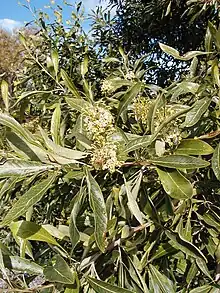Grevillea helmsiae
Grevillea helmsiae, commonly known as Helms' grevillea, is a species of flowering plant in the family Proteaceae and is endemic to Queensland. It is a shrub or tree with elliptic to narrowly egg-shaped leaves with the narrower end towards the base and small clusters of white to cream-coloured flowers with a green style.
| Grevillea helmsiae | |
|---|---|
 | |
| Scientific classification | |
| Kingdom: | Plantae |
| Clade: | Tracheophytes |
| Clade: | Angiosperms |
| Clade: | Eudicots |
| Order: | Proteales |
| Family: | Proteaceae |
| Genus: | Grevillea |
| Species: | G. helmsiae |
| Binomial name | |
| Grevillea helmsiae | |
Description
Grevillea helmsiae is a shrub or tree that typically grows to a height of 3–10 m (9.8–32.8 ft). Its leaves are elliptic to narrowly egg-shaped with the narrower end towards the base, 50–200 mm (2.0–7.9 in) long and 7–40 mm (0.28–1.57 in) wide, the lower surface silky-hairy. The flowers are arranged in small clusters 20–45 mm (0.79–1.77 in) long on the ends of branches, the rachis 4–20 mm (0.16–0.79 in) long. The flowers are white to cream-coloured with a green style, the pistil 12.5–20 mm (0.49–0.79 in) long and hairy. Flowering occurs from October to April and the fruit is a flattened elliptic follicle 20–31 mm (0.79–1.22 in) long.[2]
Taxonomy
Grevillea helmsiae was first formally described in 1899 by Frederick Manson Bailey in the Queensland Agricultural Journal from specimens collected near Childers by "Mrs. R. Helms".[3] The specific epithet (helmsiae) honours Sabine Helms, who collected the type specimens.[4]
Distribution and habitat
Helms' grevillea grows on the edges of rainforest, in dry rainforest and brigalow communities in Queensland, south from Rockhampton.[2]
References
- "Grevillea helmsiae". Australian Plant Census. Retrieved 10 May 2022.
- "Grevillea helmsiae". Australian Biological Resources Study, Department of Agriculture, Water and the Environment: Canberra. Retrieved 10 May 2022.
- "Grevillea helmsiae". APNI. Retrieved 10 May 2022.
- "Helms, Sabine (1866 - 1929)". Australian National Botanic Gardens. Retrieved 10 May 2022.